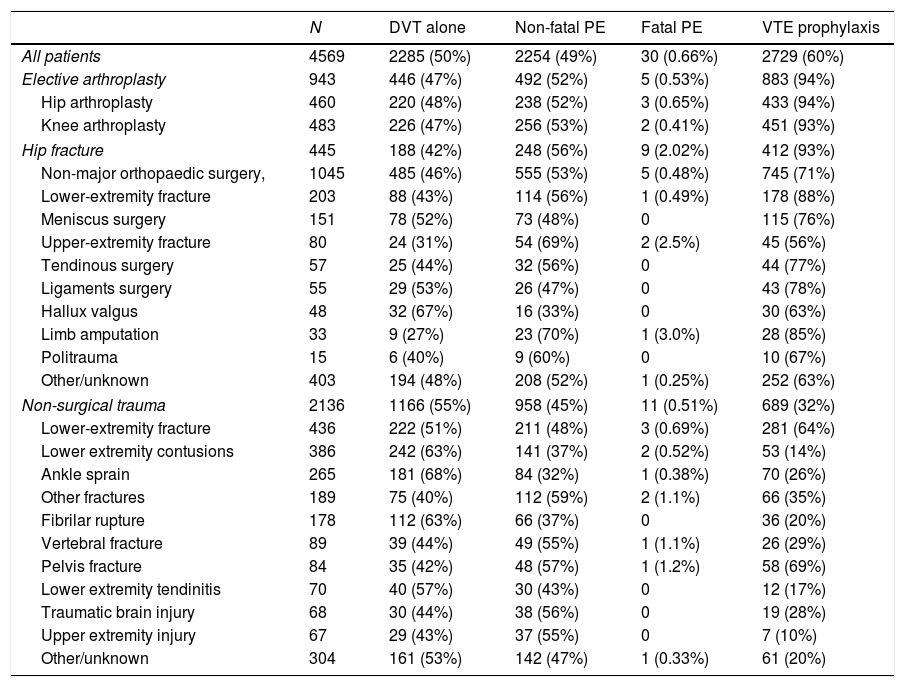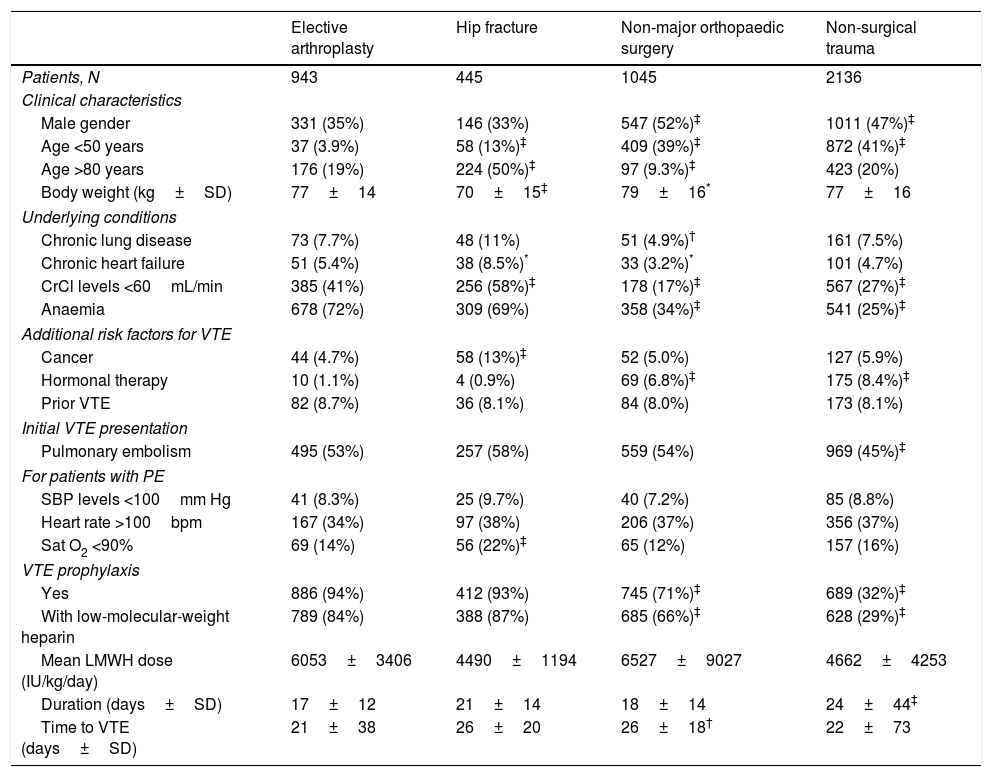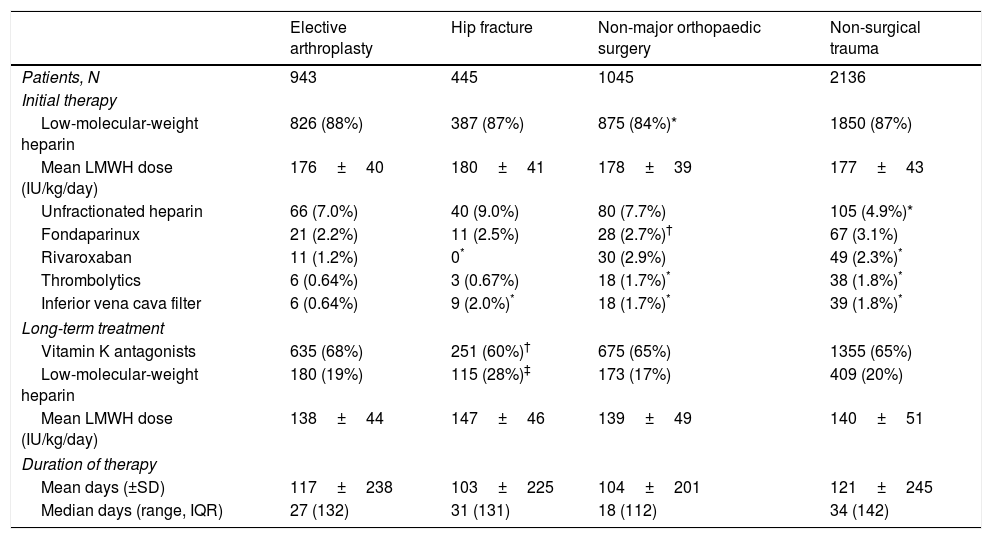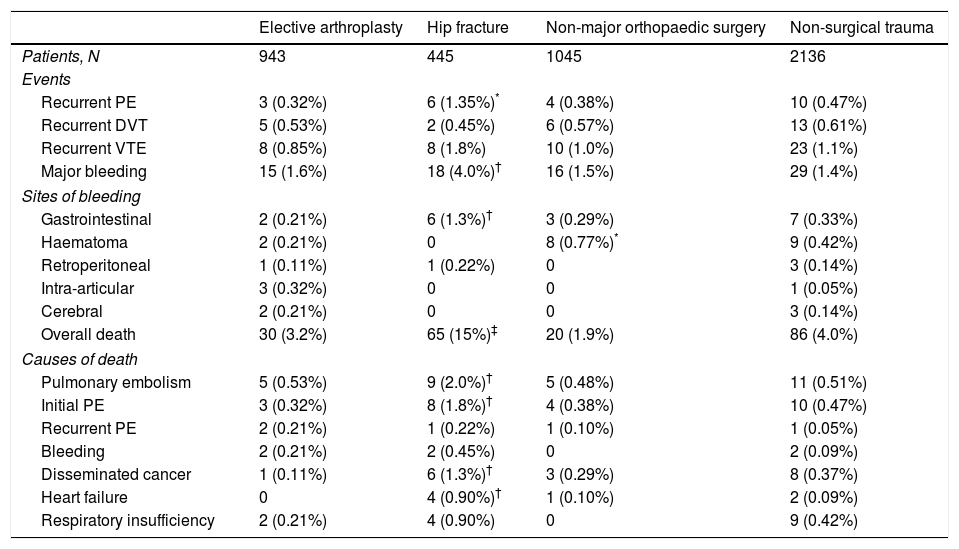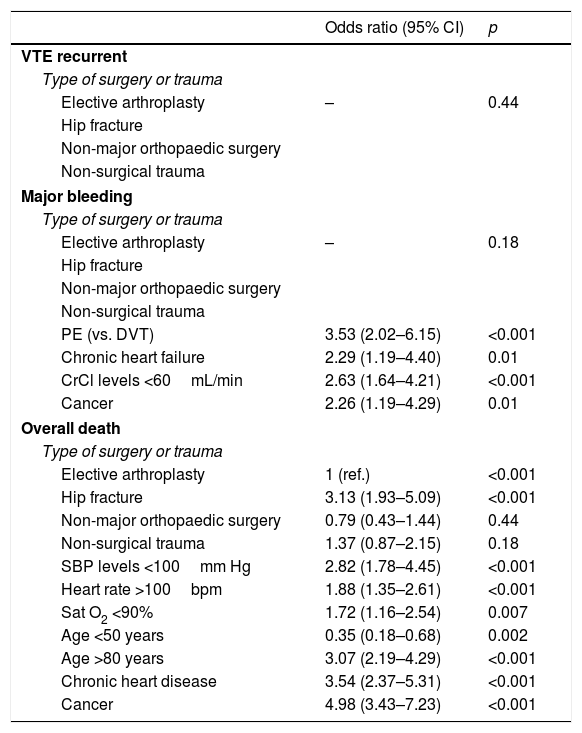There is scarce evidence about the prognosis of venous thromboembolism in patients undergoing orthopaedic surgery and in patients suffering non-surgical trauma.
MethodsWe used the RIETE database (Registro Informatizado de pacientes con Enfermedad Trombo Embólica) to compare the prognosis of venous thromboembolism and the use of thromboprophylaxis in patients undergoing different orthopaedic procedures and in trauma patients not requiring surgery.
ResultsFrom March 2001 to March 2015, a total of 61,789 patients were enrolled in RIETE database. Of these, 943 (1.52%) developed venous thromboembolism after elective arthroplasty, 445 (0.72%) after hip fracture, 1045 (1.69%) after non-major orthopaedic surgery and 2136 (3.46%) after non-surgical trauma. Overall, 2283 patients (50%) initially presented with pulmonary embolism. Within the first 90 days of therapy, 30 patients (0.66%; 95% CI 0.45–0.93) died from pulmonary embolism. The rate of fatal pulmonary embolism was significantly higher after hip fracture surgery (n=9 [2.02%]) than after elective arthroplasty (n=5 [0.53%]), non-major orthopaedic surgery (n=5 [0.48%]) or non surgical trauma (n=11 [0.48%]). Thromboprophylaxis was more commonly used for hip fracture (93%) or elective arthroplasty (94%) than for non-major orthopaedic surgery (71%) or non-surgical trauma (32%). Major bleeding was significantly higher after hip fracture surgery (4%) than that observed after elective arthroplasty (1.6%), non-major orthopaedic surgery (1.5%) or non-surgical trauma (1.4%).
ConclusionsThromboprophylaxis was less frequently used in lower risk procedures despite the absolute number of fatal pulmonary embolism after non-major orthopaedic surgery or non-surgical trauma, exceeded that observed after high risk procedures.
Hay escasa evidencia sobre el pronóstico de la tromboembolia venosa en pacientes sometidos a cirugía ortopédica y en pacientes que sufren un trauma no quirúrgico.
MétodosUtilizamos la base de datos RIETE (Registro Informatizado de pacientes con Enfermedad TromboEmbólica) para comparar el pronóstico del tromboembolismo venoso y el uso de tromboprofilaxis en pacientes sometidos a diferentes procedimientos ortopédicos y en pacientes con traumatismo que no requiere cirugía.
ResultadosDesde marzo de 2001 a marzo de 2015, se inscribieron un total de 61.789 pacientes en RIETE. De estos, 943 (1.52%) desarrollaron tromboembolismo venoso después de artroplastia electiva, 445 (0.72%) después de fractura de cadera, 1.045 (1.69%) después de cirugía ortopédica no mayor y 2,136 (3.46%) después de trauma no quirúrgico. En general, 2.283 pacientes (50%) presentaron inicialmente embolia pulmonar. En los primeros 90 días de tratamiento, 30 pacientes (0.66%, IC 95% 0.45-0.93) murieron por embolia pulmonar. La tasa de embolia pulmonar fatal fue significativamente mayor después de cirugía de fractura de cadera (n=9 [2.02%]) que después de la artroplastia electiva (n=5 [0.53%]), cirugía ortopédica no mayor (n=5 [0.48%]) o traumatismo no quirúrgico (n=11 [0,48%]). La tromboprofilaxis se utilizó con mayor frecuencia para la fractura de cadera (93%) o la artroplastia electiva (94%) que para la cirugía ortopédica no mayor (71%) o traumatismo no quirúrgico (32%). La hemorragia mayor fue significativamente mayor después de la cirugía de fractura de cadera (4%) que después de artroplastia electiva (1,6%), cirugía ortopédica no mayor (1,5%) o traumatismo no quirúrgico (1,4%).
ConclusionesLa tromboprofilaxis se utilizó con menos frecuencia en los procedimientos de menor riesgo a pesar del número absoluto de embolia pulmonar fatal después de cirugía ortopédica no mayor o traumatismo no quirúrgico, excedieron los observados después de procedimientos de alto riesgo.
Article
Diríjase desde aquí a la web de la >>>FESEMI<<< e inicie sesión mediante el formulario que se encuentra en la barra superior, pulsando sobre el candado.

Una vez autentificado, en la misma web de FESEMI, en el menú superior, elija la opción deseada.

>>>FESEMI<<<



